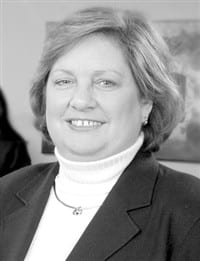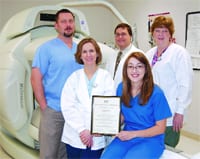Putting the Focus on Prevention That’s the Job Description for Baystate’s Director of Occupational Health
They’re called ‘flu champions.’
That’s the name Dr. Paul Medrek and other members of his team contrived to describe and recognize those who go what would be considered above and beyond in their efforts to help increase the number of Baystate Health employees who receive annual flu shots and actually get paid $25 for the privilege.
“It might be a nurse on a night shift on a medical floor who gives shots to some of her co-workers who would find it difficult to find the time to come here,” said Medrek, who told The Healthcare News that the work of these champions, as well as many other aspects of a broad program to increase the ranks of flu-shot recipients, constitute just part of a huge, evolving effort to promote health and wellness across Baystate.
They’re also part of a major career shift of sorts for Medrek, who takes the title director of Occupational Health, which means he leads the system’s Employee Health Service, an in-house provider of many work-related health care services for the system’s 10,000 employees. While still practicing medicine, Medrek, a former emergency-room physician, says his focus — and job description — has changed from exclusively treating illnesses and injuries to mostly preventing them.
And in a very big way.
“We have a very robust health and wellness program here,” he explained. “We do quite a bit of treatment, but our primary mission is prevention.”
Medrek told The Healthcare News that much of his time and energy is spent creating and refining prevention and wellness initiatives, such as the flu-shot programs, which include that $25 reward to each employee who gets one. But he must save some of it for measuring, or trying to measure, the relative worth of these endeavors in terms of such things as reducing injuries, sick time, absenteeism, visits to the doctor, and costs to the system — efforts that that will be necessary if these endeavors are to expand and gain in popularity.
“These programs aren’t cheap; this is expensive stuff, and we have to be able to show that they’re making an impact,” he explained. “We’re gathering all the data we’re going to need to show what kind of difference we’re making in terms of health care dollars spent, the number of doctor visits people make, and other measures; those questions are going to be answered over the next six months or so.”
Medrek says that what’s happening at Baystate is part of a national movement toward greater focus on prevention and wellness — one that has been slow to generate what he would consider serious momentum. The Obama administration is promising to create that momentum, he continued, adding that he believes it will happen.
“Preventing disease is where my heart is now, and that’s where it ought to be,” he said. “There was a recent article in the Wall Street Journal, of all places, written by some alternative care experts who noted that we spent something like $60 billion last year on coronary bypass surgery, and that if you spent 1/100th of that amount on prevention, you would prevent more disease than you’re treating.
“This is the way we should be thinking, and the Obama administration will be talking this up more and more,” he continued. “We’re making headway, but it’s slow.”
Shots of Adrenaline
Medrek said that one of the many responsibilities of his department, which is now under the auspicies of Barbara Pelletier, the system’s director of Health and Wellness, is to administer physicals to every potential new employee for the system. Passing that physical is a prerequisite for employment, he said, noting that, generally speaking, it’s a relatively easy grade to make for someone working in public relations or accounting (positions with small amounts of physical activity) and somewhat harder, but still easy, for those who must be on their feet all or most of the day or and/or doing some heavy lifting.
When asked how many physicals he and his staff administer, Medrek had to do some quick math in his head — essentially dividing the total 1,300 people hired last year by the number of working days in that year — before arriving at “a few dozen or so a week.”
While he would be happy to see these new arrivals, as well as those with more tenure, for a flu shot, Medrek would rather that they not be frequent visitors to his department’s three offices, the main one at 3400 Main St. in Springfield, just a few blocks from Baystate Medical Center. That’s because, while his office is charged with treating injuries sustained on the job — everything from slips and falls to suspected carpal tunnel syndrome to back injuries resulting from lifting patients (perhaps the most common problem) — its main reason for being is to prevent such things.
“We want our employees healthy, and we want them at their best,” he said, noting that prevention is really the heart and soul of his department’s work. “We don’t want you to have to come here at all.”
And this work represents a radical departure from what Medrek was doing earlier in his career. After graduating from UMass Medical School, the East Longmeadow native completed a residency in emergency medicine in Ohio, and then worked for 11 years in the ER at Mount Auburn Hospital in Cambridge, while also teaching at nearby Harvard Medical School. He then tacked into prevention and a job as medical director at the Center for Occupational and Environ-mental Health in Exeter, N.H.
He said he came to Baystate and its Employee Health Service three years ago to pursue a new and different kind of challenge, one that enables him to be part of what he expects will be a pronounced national shift in focus from treatment to prevention.
When asked to list some of the ways his wellness and prevention efforts are manifested, Medrek started with the flu-shot program.
“For some reason, and I’m not really sure why, doctors and nurses are notorious for not getting flu vaccines,” he explained. “I don’t think it has to do with needles, but just a feeling that they don’t need one; I don’t get it, really.”
Thus, the system, and specifically its Employee Health Service, set about convincing them that they did, and creating a strategy that Medrek described as a simple ‘carrot and stick’ approach.
“These shots are not only free … last year we paid you $25 if you got a free shot,” he said. “We obviously believe it’s very important to prevent the flu. “If you’re not going to get a flu shot, we want to know why, and people are required to tell us. We then look at those reasons and tailor our message for the next year accordingly.
“People will say, ‘I’m healthy … I don’t need a flu shot,’” he continued. “Our message then becomes, ‘it’s not just for you; you can come down with the virus and not get that sick, but bring it home to your 1-year-old or your grandmother.’”
The various efforts, including the cash enticement and ‘flu champions,’ have brought the percentage of system employees who have received a shot from 35{06cf2b9696b159f874511d23dbc893eb1ac83014175ed30550cfff22781411e5} to 76{06cf2b9696b159f874511d23dbc893eb1ac83014175ed30550cfff22781411e5} over the past two years, said Medrek, adding that he’s now focused on the 24{06cf2b9696b159f874511d23dbc893eb1ac83014175ed30550cfff22781411e5} still to get on board.
Another example of prevention efforts is the Healthwise Handbook, a “home health reference book,” as he called it, that the Baystate system distributes to hundreds of employees each year. The 354-page compendium is broken down into sections — from “First Aid and Emergencies” to “Living Better with Chronic Disease” to “Staying Healthy” — and is designed to help employees and their families make smart decisions about health and wellness.
“It details things you can do to take care of minor things at home, stay healthy, and maybe prevent a few doctor visits a year,” he said, adding that the handbook is one of many ways the system is focusing on prevention to hopefully bring down the cost of health care in the region.
Prevent Defense
As he talked about his transition from treating disease and injury to preventing them, Medrek described his current work as “incredibly rewarding.”
That’s because, even if he doesn’t have all the hard, statistical evidence to prove it yet, he knows the work of his department is making a difference in terms of the health and wellness of employees and the overall costs being paid by the system.
“Some of the metrics we’re looking at involve moving employees into ‘low-risk’ categories for events like heart attack and stroke,” he explained. “And we’re also measuring employee engagement — how many employees are involved in our health and wellness programs; we can see some progress.”
Thanks, in part, to the work of those flu champions.


